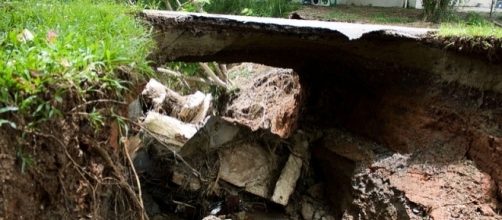Hurricane Maria devastated Puerto Rico and it is still a Category 3 storm raging over the Atlantic. Residents in the East Coast of the United States have been cautioned about possible consequences as the hurricane moves away from the Caribbean and Puerto Rico. Its path could cross the East Coast.
The National Weather Service has warned people of the Mid-Atlantic States that Maria could bring life-threatening swells with waves of up to 7ft accompanied by beach erosion.
No respite from hurricanes
Daily Mail UK reports that the fury of Hurricane Maria led to the failure of a dam in Puerto Rico.
Rains deposited nearly 16 inches of water in the lake and the 90-year old dam was unable to withstand the pressure. The water spilled into human settlements. It was a sort of flash flood and thousands of people were affected and were told to evacuate.
Governor Ricardo Rossello confirmed the death of seven people. The hurricane led to large-scale destruction of properties and power outage. Most of the mobile towers were down and communication links disrupted. In financial terms, Maria has inflicted damage to the extent of $45billion and loss in business to the tune of $30billion in Puerto Rico.
Maria is now shifting towards The Bahamas and Bermuda and could strike the southeastern coast of the United States.
The US has to brace up for Maria
The United States is still trying to recover from the ravages of Harvey and Irma. Hurricane Maria, which has wreaked havoc in Puerto Rico, is a new threat. It is expected to strike the US and will be accompanied by 7 ft high waves and strong winds and could affect the East Coast.
On 25 September in an update from CNN, it was reported that "North Carolina may bear the worst of the storm, as current forecasts show Maria brushing its coast Wednesday morning."
Irma was one of the most powerful Atlantic storms on record and it left 80 dead in the Caribbean and the Florida region.
Before that, it was Harvey in Houston, Texas where there were similar figures of casualty. Apart from the loss of lives, there was unimaginable destruction to properties and surrounding infrastructure from the two hurricanes. The cost of restoration could run into billions of dollars.
A section of the scientific community believes global warming is a factor that contributes to the unnatural pattern of weather and disasters like hurricanes.
In their opinion, temperatures are rising all over the world and droughts and wildfires have become more frequent. The atmospheric heat dissipates into the oceans which, in due course of time, break up the bodies of ice at the Poles. These melt and lead to rising sea levels.


